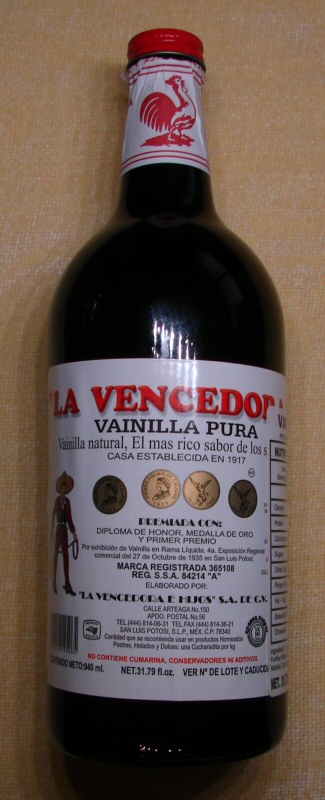
My daughter mentioned that we need vanilla for cooking, so today at the store I stood looking at all the options in the spice aisle. Vanilla Extract, USDA certified organic vanilla, Madagascar vanilla. My head started to spin. I remember being a young girl and my grandparents brought a large bottle of REAL Vanilla back from Mexico. The bottle had to be about 1 liter in size. In the past I have been able to find the same bottles here in Mexican markets. The last time I went to a tinderia I was not able to find any. But given my recent luck with honey I opted to do so research before buying any vanilla for the upcoming baking season. You know how much I LOVE to do research.
Of course I could not keep this info to myself, I had to share it with my all my friends
Your Options in Vanilla
Pure Vanilla Extract
Pure simply means it is not artificial. Pure vanilla extract is made by steeping chopped vanilla beans with ethyl alcohol and water. Manufacturers can use a variety of types and qualities of beans. The process of extraction takes about 48 hours then the mixture is placed in tanks from anywhere from a few days to several weeks. The aged mixture is then filtered, placed in holding tanks and eventually bottled. I was surprised to find out that pure extracts may still contain sugar, corn syrup, colors and stabilizers.
Natural Vanilla Flavoring
Natural Vanilla Flavoring is derived from vanilla beans, but usually has no or little alcohol.
A natural vanilla flavoring is derived from vanilla beans but has little or no alcohol. Natural Vanilla Flavorings might have sugar, glycerin or propylene (polypropylene) glycol base. Natural Vanilla Flavoring are typically used in cooking and baked goods both at home and in commercial establishments.
Glycerin and propylene (polypropylene) glycol are FDA approved food additives. Propolyne Glycol has several uses, among them as a carrier in fragrance oils. Glycerin is used as a sweetener, and may help preserve foods.
Artificial/Imitation Vanilla FlavoringU.S. manufactured artificial vanilla is produced from synthetic "vanillin", Lignin Vanillin, which is made from wood by-products of the paper iindustry. This by product is chemically treated, with flavor packets, similar to those that scent perfume, to mimic the flavor of vanilla. Discerning palates find the imitation vanilla products to have a harsh quality with a bitter aftertaste. Despite it’s initial low cost it is not really less expensive, as it takes twice as much imitation vanilla flavoring is required to match the strength of pure vanilla extract
Tonka Beans
That’s right, some vanilla is not made from vanilla beans. The Brazilian tonka bean can be used to make a flavoring similar to vanilla. The big problem with tonka beans is that they contain coumarin. Coumarin is toxic, causes liver damage and is a known carcinogen. Coumarin is banned from products sold in the United States since the 1950’s. Coumarin is used extensively in synthetic vanillas made in Mexico, and the FDA still finds products containing coumarin in some ethnic food store.. If you buy Mexican vanilla make sure it is clearly labeled “coumarin free”. Lacking strict labeling laws as we have in the U.S., Mexican manufactured products may not list accurate ingredients.These products often are labeled in Spanish “Extracto de vainilla” or “Vainilla.” Again, purchase from a reliable source and steer clear of those large "bargain" sized bottles from Mexico
Synthetic Mexican Vanilla
Most of the vanilla extracts that come to the US from Mexico are synthetic. The best way to determine quality is price. If you are offered a large bottle for a cheap price it is most assuredly a synthetic product. Also, real vanilla is not "clear". No matter what the label may tell you if it is clear it is synthetic. True vanilla is amber colored. Synthetics tend to be dark and murky either from the coal tar from which they are produced or from caramel and red food colorings. Pure vanilla is expensive because it is difficult to grow commercially and is tedious to process. Actually, Mexico is no longer a significant producer of vanilla--most of it now comes from Madagascar where it can be produced more economically.
What are our Options for Vanilla?
Is it real? So how do you know if it's real vanilla. If it's in a big bottle and cheap , it is not real vanilla. If it's expensive it is either real vanilla or it's a tourist rip-off. Since it is expensive, it is more likely to be sold in smaller bottles. Real vanilla has an amber color. Synthetic vanilla is often darker in color. Pure Mexican vanilla, though rare, is still some of the best vanilla there is. Whole vanilla beans may also be purchased. The Mexican vanilla bean is thicker and darker than the Madagascar bean. Look for beans that are moist, plump and tender, not shriveled and hard. It all goes back to reading our labels. Make sure what you are buying is labeled as vanilla, and is labeled in English. There are several recommended top Brands of Vanilla. Another option is to make your own vanilla extract. After researching my options I think that is the route we will be taking.On a Personal Note

In doing my research I learned that the brand I had bought in Mexican Markets and most likely the same brand that my Grandparents bought years ago is not actually vanilla.
1 comment:
Hi! Following you from a blog hop!:0)
Hope you visit me and return the follow!
Btw if you like please join the Treasure
Trove Tribune! I think you will enjoy
it!:0)
Post a Comment
Thanks for stopping by. I love my visitors, and I love your comments too!